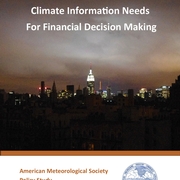Download Report
Download Two-Page Summary
Key Findings
The United States invests roughly $1.5 trillion U.S. dollars (USD) in capital assets each year across the public and private sectors (Orszag 2008; United States Census Bureau 2013).
Extreme weather events create and exacerbate risks to these financial investments by contributing to:
-
Direct physical impacts on the investments themselves
-
Degradation of critical supporting infrastructure
-
Changes in the availability of key natural resources
-
Changes to workforce availability or capacity
-
Changes in the customer base
-
Supply chain disruptions
-
Legal liability
-
Shifts in the regulatory environment
-
Reductions in credit ratings
Even small changes in weather can impact operations in critical economic sectors. As a result, maximizing returns on financial investments depends on accurately understanding and effectively accounting for these risks.
Climate variability and change can either exacerbate existing risks or cause new sources of risk to emerge.
Managing these risks most effectively will depend on scientific advances and increases in the capacity of financial decision makers to use the scientific knowledge that results.
Barriers to using climate information must also be overcome. This study proposes three predefined levels of certainty for communicating about weather and climate risks: 1) possible (i.e., unknown likelihood or less than 50% chance of occurrence), 2) probable (greater than 50% chance of occurrence), and 3) effectively certain (at least 95% chance of occurrence).
For example, it is effectively certain that a change in climate will alter weather patterns. It is probable that climate warming will cause increases in the intensity of some extreme events. It is possible that climate change will cause major and widespread disruptions to key planetary life-support services.
Key recommendations of this study:
1) Identify climate-related risks and opportunities for financial decision making.
2) Create a framework to translate scientific information in clear and actionable terms for financial decision makers.
3) Analyze existing climate assessments and translate projected impacts into possible, probable, and effectively certain impacts.
4) Improve climate projections with respect to precipitation (timing, amount, and intensity), extreme events, and tails of probability distributions (i.e., low-probability but high-consequence events).
5) Increase spatial resolution of climate projections in order to provide climate information at the scale most relevant to financial investments.
6) Improve projections of the societal consequences of climate impacts through integrated assessments of physical, natural, and social sciences.
7) Create a user-friendly information repository and portal that provides easy access to information relevant to financial decision making.
8) Create and maintain opportunities to bring together financial decision makers, scientists, and service providers.
Near-term financial decisions have long-term implications for the United States’ social and economic well-being that depend, in part, on climate variability and change.
Investments will be most successful, and will advance the interests of society most effectively, if they are grounded in the best available knowledge & understanding.
Full report available for download: www.ametsoc.org/cin
